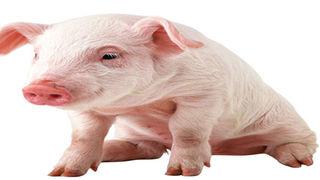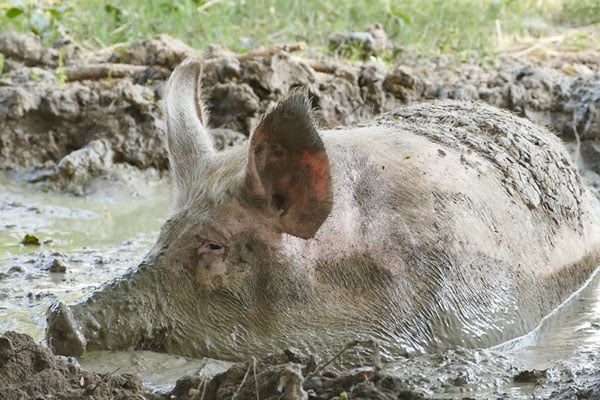
A pig. PHOTO/FILE
|Farming
Prime
How poor hygiene leads to slow growth of pigs
What you need to know:
- Sudden loss of staff on a livestock farm can offset established management systems and result in poor performance.
- New workers on a farm always have a one to two months learning curve to understand how the farm is managed.
Mike’s farm hosts some 1000 pigs and he has always had a good manager since he started farming six years ago. Three weeks ago, he asked me to visit the farm. He had noticed that his pigs were taking too long to attain the baconer weight.
Smelling pigsty
Upon arrival on the farm, I noticed something was amiss. There was higher concentration of piggy smell in the air. On my last visit about seven months earlier, I could hardly pick the smell. Smelly pig farms indicate poor disposal of waste, poor hygiene and cleanliness.
I was received by Wekesa, the farm manager. He told me he had only been on the farm for two months. I noticed many of the farm workers were new. I called Mike and he confirmed that he had had a heavy turnover of staff.
Sudden loss of staff on a livestock farm can offset established management systems and result in poor performance. New workers on a farm always have a one to two months learning curve to understand how the farm is managed.
Wekesa informed me the pigs were taking too long to mature. They would go up to eight months. Piglet deaths were about six percent compared to the expected below two per cent. During my last visit, the piglet mortality had consistently been one to two per cent from birth to baconer maturity. Pigs also matured at about six months. I noticed, from the farm records, problems had started with the exit of the farm manager I had left on the farm. He had worked there for six continuous years. There had been two other managers before Wekesa, who had left soon after being recruited. I also noticed four of the most experienced staff had left within the problematic period.
Death of piglets
The main cause of death of the piglets was recorded as diarrhoea, pneumonia and weight loss. It was said the piglets would get thin over some time and then die either after weaning or while still suckling. There was no specific diagnosis for the cause of diarrhoea or pneumonia.
Next, I carried out observation in all the production units and examined sick animals. I did not find it necessary to take samples for laboratory examination.
I observed the finisher pigs were maturing at seven months. That was already above the recommended six months. Any time between 5.5 and 6.5 months is acceptable.
Cleaning and disinfection
The grower pig pens had the same hygiene issues as the finisher pens. Urine had also stagnated in some of the pens, explaining the piggy smell I had picked in the air. When the urine stagnates, bacteria breaks it down and generates the piggy smell which wafts into the air.
Most of the grower pigs were below their expected weights. I also noticed that some were sneezing or had occasional coughs. That was an indication of the long-standing or chronic respiratory infections. The most common cause of such infection is a bacterium called mycoplasma. I treated the sick pigs with the recommended antibiotic by intramuscular injection that I would give for three days. The nursing piglets had most problems.
Some were coughing and most had whitish or yellowish diarrhoea. Most of them were thin and their body weights were lower than their age. The pens were also unhygienic. I recommended cleaning and disinfection of the pens.
I treated the piglets with antibiotic and multivitamin injection. I also gave antibiotics by mouth and instructed Wekesa how he would repeat the oral treatment for another four days. The prolonged diarrhoea due to unhygienic conditions was the major cause of the stunting of the pigs.
Fights in a pigsty
When well-fed and kept, they are lovely to watch, especially when young. Their bodies are clean and nicely rounded.
One farmer who kept lots of pigs once told me they provided him psychotherapy just by watching them feed, play and rest every time he came back home from his busy office.
Unfortunately, pigs can be nasty when they do not agree with one another. They can even fight to death. Betty has been keeping pigs since 2016, mostly without many fighting incidents. But she has witnessed an unusual aggressive behaviour in her animals in the last six months.
The behaviour appears random but I have requested her to track down the breeding history of the affected pigs. They have of late started fighting and killing selected pigs.
I identified the main cause of the fighting to be crowding and poor ventilation when it started last year.
Betty adjusted the pig numbers in every lot to give at least one square metre per animal. She also broke down some of the walls of the pens for adequate air circulation.
The problem appeared to be ending but re-emerged with a vengeance in December 2021. It has spilled into January this year.
The fighting resumed and there does not appear to be a pattern in the affected groups. The animals are in the porker and grower stages. The most common cause of fighting in pigs is to establish dominance.
Whenever a new animal is introduced in a pen, it will either be fought by group members and it fights back or it will choose to submit to the authority of the group.
Submitting pigs will lower their heads and rush to a corner or lower the head and hide it away from the snouts of others.
Pigs use their snouts to hit others. They mainly like biting the ears and hitting the body and the neck areas.
Losses
A pig fight can be extreme, causing deep body lacerations and drawing lots of blood. Betty’s pig fights have been as bad as they can be. She has lost at three pigs directly to the fights. There are others she slaughtered as an emergency to avoid losing them. The only thing I noted is that Betty has not been using the essential amino acid, tryptophan, in her self-formulated feed. Its deficiency is thought to indirectly cause aggression in pigs.
Tryptophan is used in the body to produce the hormone serotonin. Insufficiency of serotonin causes mood swings, including depression, anxiety and aggression. I could not, however, diagnose serotonin deficiency because only pigs in some pens were affected. Further, I did not have evidence that the pigs had lower than normal levels of serotonin.
I advised Betty to use the amino acid in her feed formulation and observe if there would be a reduction in the fighting.
Boredom is another cause of fights. The animals have a lot of energy and they are inquisitive.
Boredom leads to ear and tail biting. The actions cause bleeding, making the animal appear different from the others.
The pigs curiously bite the bleeding spots, with the affected animal fighting back in self-defence.
That starts the vicious cycle of biting and retaliation before becoming a full scale war.
I advised Betty to increase the number of play chains in the pens to about five pigs per chain.
Chains have been proved to engage pigs in play and dissuade them from fighting. Stress can also cause fighting in pigs.
It may be brought about by congestion, poor ventilation, poor food quality, unusually loud noises and excessive heat.
Symptoms
The major symptom of banana weevils according to Disan Muwanga is the formation of vertical openings on some of the outer sheathes of the banana stem.





